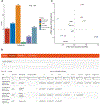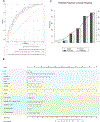Identification of genetic profile and biomarkers involved in acute respiratory distress syndrome
- PMID: 37922010
- PMCID: PMC11167213
- DOI: 10.1007/s00134-023-07248-9
Identification of genetic profile and biomarkers involved in acute respiratory distress syndrome
Abstract
Purpose: The purpose of this study was to profile genetic causal factors of acute respiratory distress syndrome (ARDS) and early predict patients at high ARDS risk.
Methods: We performed a phenome-wide Mendelian Randomization analysis through summary statistics of an ARDS genome-wide association study (1250 cases and 1583 controls of European ancestry) and 33,150 traits. Transcriptomic data from human blood and lung tissues of a preclinical mouse model were used to validate biomarkers, which were further used to construct a prediction model and nomogram.
Results: A total of 1736 traits, including 1223 blood RNA, 159 plasma proteins, and 354 non-gene phenotypes (classified by Biochemistry, Anthropometry, Disease, Nutrition and Habit, Immunology, and Treatment), exhibited a potentially causal relationship with ARDS development, which were accessible through a user-friendly interface platform called CARDS (Causal traits for Acute Respiratory Distress Syndrome). Regarding candidate blood RNA, four genes were validated, namely TMEM176B, SLC2A5, CDC45, and VSIG8, showing differential expression in blood of ARDS patients compared to controls, as well as dynamic expression in mouse lung tissues. Importantly, the addition of four blood genes and five immune cell proportions significantly improved the prediction performance of ARDS development, with 0.791 of the area under the curve from receiver-operator characteristic, compared to 0.725 for the basic model consisting of Acute Physiology and Chronic Health Evaluation (APACHE) III Score, sex, body mass index, bacteremia, and sepsis. A model-based nomogram was also developed for the clinical practice.
Conclusion: This study identifies a wide range of ARDS relevant factors and develops a promising prediction model, enhancing early clinical management and intervention for ARDS development.
Keywords: Acute respiratory distress syndrome; Biomarker; Causal factor; Mendelian randomization analysis; Phenome-wide association study.
© 2023. Springer-Verlag GmbH Germany, part of Springer Nature.
Conflict of interest statement
Declarations
Conflicts of interest
The authors have declared that no conflict of interest.
Figures





References
-
- Fan E, Brodie D, Slutsky AS (2018) Acute respiratory distress syndrome: advances in diagnosis and treatment. JAMA 319:698–710 - PubMed
-
- Bellani G, Laffey JG, Pham T, Fan E, Brochard L, Esteban A, Gattinoni L, van Haren F, Larsson A, McAuley DF, Ranieri M, Rubenfeld G, Thompson BT, Wrigge H, Slutsky AS, Pesenti A (2016) Epidemiology, patterns of care, and mortality for patients with acute respiratory distress syndrome in intensive care units in 50 countries. JAMA 315:788–800 - PubMed
-
- Bernard GR, Artigas A, Brigham KL, Carlet J, Falke K, Hudson L, Lamy M, Legall JR, Morris A, Spragg R (1994) The American-European European Consensus Conference on ARDS. Definitions, mechanisms, relevant outcomes, and clinical trial coordination. Am J Respir Crit Care Med 149:818–824 - PubMed
MeSH terms
Substances
Grants and funding
LinkOut - more resources
Full Text Sources

